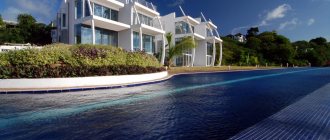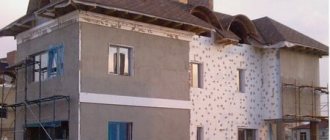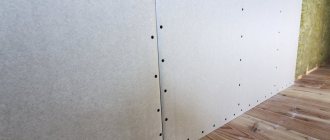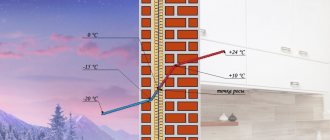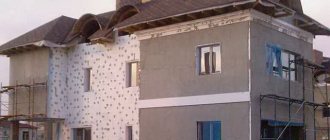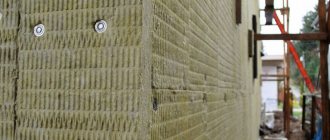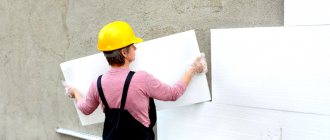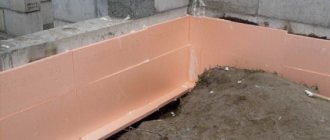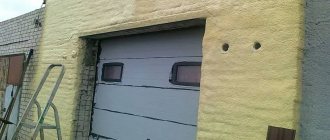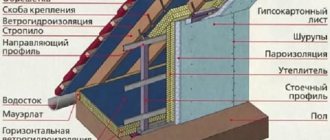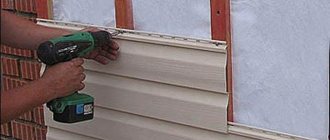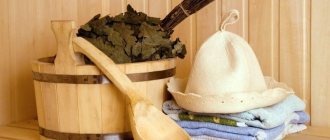Insulation of the facade of a panel house from the outside
Living in a panel house is not always comfortable, since in winter the facade can freeze, moisture can accumulate on it, and mold can form. This leads to peeling of the wallpaper and an uncomfortable microclimate in the room - the temperature in the room is below a comfortable level. This is due to the properties of the walls of the panel structure, which are not characterized by resistance to changes in temperature and high humidity. To solve this problem, you will have to insulate the walls, and this must be done from the outside.
Photo of an insulated facade of a panel house
Features of insulation of interpanel seams
Most of the thermal energy is consumed through the seams between the panels. The problem is solved by filling such voids with a monolithic mortar that eliminates all holes, cracks and cavities in the seams. The presence of such treatment increases the efficiency of thermal insulation of the house.
Compositions for treating seams are sold ready-made or as ingredients for preparing solutions. They contain polystyrene foam granules that retain heat, or air particles that protect the room from the penetration of cold air from outside.
If the distance between the plates is large enough, it is allowed to seal the seams with insulating fiber with a soft texture, such as mineral wool. The material is characterized by its ability to be compressed, ease of installation and durability.
Insulation options
Insulating a panel house from the outside allows you to stop the flow of heat through the concrete. An additional layer of thermal insulation will provide protection from the destructive effects of external factors. On the market today you can find many materials that can be used for insulation inside or outside.
Insulation inside
For a panel house, insulating it from the inside will only make the situation worse. This is due to the movement of the dew point, which will move closer to the inside of the wall. In practice, this means that moisture will accumulate in the walls with even greater force - both the wall and the insulation will get wet, so the service life of the facade will be significantly reduced. To avoid such a situation, and at the same time reducing the usable area of the apartment and destroying the design, you should give preference to insulating a panel house from the outside.
Insulation from outside
The difficulty is that insulating a panel house with a large number of floors is only possible with the help of climbing equipment. It is clear that it is almost impossible to get money to pay specialists and buy building materials from utility services. Moreover, an attempt to insulate a house at the expense of the residents also does not always meet with understanding from all project participants. Therefore, you can take the path of least resistance and insulate a separate apartment.
The main advantages of external insulation:
- There is no need to disturb the interior decoration of the premises;
- The internal usable area of the apartment is preserved;
- The supporting structure of the “socket” is strengthened, that is, the building is strengthened, which has a positive effect on its service life;
- The insulation is an additional sound insulator;
- The temperature inside the room increases with the same heating costs, since the walls are protected from freezing - heat loss through the panel box is reduced.
What options do we choose from?
Let's say you clarified all the details and received the go-ahead to insulate the facade. The next question is: which technology to choose? There are two main options.
Plaster (wet) facade
This method involves multi-layering: first a layer of insulation is installed, then a reinforcing mesh, and finally finishing plaster. This is a universal and fairly reliable option, but labor-intensive and time-consuming (the work will take a week or more). The main disadvantage of the technology, perhaps, is that installation work can only be carried out at above-zero temperatures and in good weather. Manufacturers claim that the service life of a wet facade will be 20-30 years (but cosmetic repairs are needed every four to seven years).
Ventilated (hinged) facade
This method is more popular than the plaster (wet) facade. The principle of insulation is as follows: first, a metal frame is mounted, then insulation is laid, and a screen is attached on top. An air gap is left between the screen and the insulation. When a ventilated façade is installed correctly, the accumulation of moisture in it is eliminated, and hence the formation of fungus or mold. One of the advantages of technology is the huge selection of exterior design options. Facade screens can be made of vinyl siding, aluminum panels, composite façade panels and so on. Among other things, ventilated facades can be installed all year round, regardless of the outside temperature. The installation speed is higher than that of a plaster facade (from three days), and the structure can last up to 50 years.
Alexander Zamaraev/Fotolia
How to choose insulation
When choosing insulation for outdoor use, you should consider the following factors:
- Climate of the region in which the panel house is located
- Wind rose and precipitation
- Available budget
- Local features, for example, the design project of the building facade.
To calculate the estimate and create a project, you must contact the management company or the HOA, while a team of industrial climbers will directly handle the insulation
Thermal conductivity diagram for building insulation
Types of insulation for panel houses
The following materials can be used for thermal insulation of a panel house:
· mineral wool
Mineral wool is one of the most popular insulation materials for outdoor use. This is due to good performance characteristics, in particular, low thermal conductivity. At the same time, mineral wool is hygroscopic, so it is important to insulate it from moisture. Otherwise, the thermal insulation properties are leveled. For this purpose, it is necessary to lay a vapor-permeable membrane under the insulation layer - it will protect the mineral wool from moisture. You can also create an air gap in the ventilated facade - in this case, a membrane is not needed.
· extruded polystyrene foam and polystyrene
Polystyrene foam and extruded polystyrene foam, or, as it is also called, penoplex, also have low thermal conductivity, so they can be used as insulation for a panel house. Moreover, if you choose from these materials, then most often foam is used as a heat insulator.
This material attracts with its lightness; moreover, such slabs can be mounted on the wall without any problems. In addition to thermal insulation, they provide additional insulation from sounds from the street. At the same time, when selecting a material, it is important to note the marking - foam plastic should be G1, which means “does not support independent combustion. If the foam is flammable, it should not be used. It is worth considering that the labeling does not always correspond to the real state of affairs. Therefore, when purchasing thermal insulation material, you must request a certificate for the product - it must comply with GOST 30244-94.
Insulation materials
The modern construction market offers an alarmingly large selection of thermal insulation materials. The “ordinary” man in the street, not familiar with the specifics of the work, is dizzy from such diversity. Unscrupulous sellers take advantage of this, instilling the idea “the more expensive, the better.” Today we will not consider all the options for insulating the external walls of a house, but we will talk about the most inexpensive, high-quality materials that have been proven over the years.
Styrofoam
Among the most popular insulation materials, foam occupies a special place. This is an inexpensive material that properly performs its intended function. It is perfect for external insulation, as it provides 100% thermal insulation regardless of air humidity and temperature changes.
This material is non-toxic and fireproof, but a reservation should be made here. The foam itself does not burn, but melts and at the same time emits black acrid smoke, which is hazardous to health. But if you follow safety measures, it will last a long time and faithfully. The words about non-toxicity and harmlessness to health are confirmed by the fact that even children's products and food products are packaged in polystyrene foam.
Polyfoam is not susceptible to mold, fungi and insects. It does not deteriorate, does not swell or shrink, maintaining its original shape. The service life of the material ranges from 20 to 50 years, depending on the quality.
External insulation of the walls of a house with foam plastic allows not only to protect the interior from the vagaries of the weather, but also transforms the outside of the house. The material creates a very convenient surface for finishing, ranging from relief plaster to siding or slabs.
Working with polystyrene foam is quick and easy; all you need is basic skills and equipment.
Stages of insulating the external walls of a house with polystyrene foam:
- Prepare the walls by cleaning them from dust and dirt with a construction brush. If there are cracks or chips, seal them with plaster so that the foam sticks well.
- Glue the foam plastic with a special compound onto the pre-primed wall. You need to glue the sheets in a checkerboard pattern, pressing them closely together. To ensure that the material holds well, additionally secure it with plastic dowels.
- Install fiberglass mesh over the slabs. To do this, apply a thick 5 mm layer of glue to the sheets and “drown” the mesh in it.
- All that remains is to plaster the surface, cover it with facade paint or perform any other finishing.
Penoplex
Today you can often hear advertisements for high-quality and reliable penoplex insulation, which is why many people believe that this is the name of the material. In fact, the material is called extruded polystyrene foam, and it is produced under the Penoplex brand.
Extruded polystyrene foam is used for internal and external insulation of houses of any type. Today it is one of the most popular materials, and this is explained by its excellent performance characteristics.
Advantages of penoplex:
- environmental friendliness;
- low thermal conductivity;
- high density;
- retains heat better than foam;
- high strength;
- high density;
- low vapor permeability;
- absolute fire safety (ignition temperature 500C, which is unrealistic at home);
- durability;
- ease of working with the material;
- relatively low cost, which quickly pays for itself.
Unfortunately, ideal building materials do not yet exist, so even with such a large list of advantages, penoplex also has disadvantages. The most obvious is poor adhesion. Since the material is very dense, it does not absorb adhesives well, so it is difficult to glue it to a vertical surface. To do this, additional fixation is performed with dowels, but most builders recommend using penoplex for internal insulation.
External insulation of the walls of a house with penoplex is best done in the basement area, since even additional fixation of the material will not protect it from damage. In other words, it very quickly begins to fall off and spoils the appearance of the building. In the area of the plinths, you can make a ventilation space or use an outer layer of waterproofing to prevent the adhesive layer from getting wet and breaking down.
https://youtube.com/watch?v=KA5pPEDRxwY
External insulation
Carrying out work on insulating the facade of a multi-storey building
Insulating the facade of a panel house is carried out in the following stages:
Preparatory stage
Preparation of the facade surface is necessary - the end walls of the panel house are leveled, the slabs are cleaned of plaque. It is also important to seal voids and cracks; panel joints are sealed. If necessary, it is worth laying a sealant between the joints, while special mastic is used to seal cracks. Unevenness of the wall surface is allowed within two centimeters - such a deviation does not need to be repaired. When all the materials are dry, the wall is impregnated with a universal primer, which is applied using a sprayer or roller.
Installation of insulation
Since in the vast majority of cases foam plastic is used for thermal insulation of panel houses, it is worth considering the technology for installing this insulation. You can fix the foam using the following methods: placing the slabs on glue, fastening them with dowels, or combining these two options, which is the most reliable choice. The direction of pasting is from bottom to top. In this case, pasting begins with the installation of the starting strip.
After this, we begin to apply glue to the surface of the panel house - the technologies used directly depend on the quality of the walls. If they are smooth, then you can apply glue with a comb. If, as often happens, the walls are uneven, then the glue is simply thrown onto the surface. It is important to carefully fill the seams with glue. All this allows you to get rid of voids under the heat insulator. There is no need to apply glue to the foam.
Installation of foam plastic on the wall
The option when the glue is applied to the foam plastic, and not to the house, is not suitable in this case, since the voids under the insulation will become natural cold bridges, which will reduce the effectiveness of the entire event.
We apply the foam to the glue layer and press it well. After gluing all the plates, you need to leave them alone for several days. During this period, the adhesive solution will dry and shrink, after which the next stage of work can be performed. As for fastening the slabs with dowels, you can choose plastic mushrooms. This is due to the lightness and low strength of foam plastic - such fasteners will save the facade from unnecessary heat loss.
It is worth paying attention to the gaps - they must be filled with foam, cutting off the excess after the material has hardened.
As for the dowel caps, they must be covered with an adhesive mixture. All irregularities remaining after the glue has dried can be removed with regular sandpaper.
Preparation for reinforcement
The fragility of polystyrene foam is a serious drawback, so the insulation needs reinforcement - just glue a thin mesh. Such protection should prevent the destruction of the foam due to atmospheric phenomena and other unfavorable factors.
Preparation for reinforcement proceeds as follows: first, the corners are pasted over, after which you can proceed to pasting the walls themselves. To simplify the process, meshes with ready-made corners are used, which minimizes time consumption. If there are no such meshes, then you will have to make corners from a regular mesh. It is enough to cut a long strip 30 centimeters wide and bend it at an angle - this design is pressed against the corner of the house greased with glue. In general, cutting the mesh into fragments greatly simplifies the installation itself, which allows you to sequentially cover the areas coated with glue with fragments. In this case, the mesh should overlap at the junction.
After gluing the mesh, you need to wait for the glue to dry, after which you can use a plastic float to clean off the excess solution and remove any unevenness.
Scheme of insulation of the facade of a panel house
Choosing a material for insulating an apartment building
The range of insulation materials for external walls is huge. Everyone has a preference based on the relevance of application in each situation.
Insulation using foam plastic
The material is widely used for wall insulation. Most of the structure is air foamed with plastic masses, so it is a very good heat insulator. Considering the features of insulating facades using polystyrene foam, the following advantages can be emphasized:
- environmentally friendly;
- low thermal conductivity;
- impervious to steam and water;
- fireproof;
- low specific gravity;
- inexpensive.
In addition, the material can last for a long time. It does not disintegrate when attacked by various microorganisms.
Despite all the advantages, polystyrene foam has its disadvantages:
- can be destroyed under the influence of external forces;
- facade paints with an aggressive structure can cause damage;
- poor air permeability.
Mineral slabs as insulation
The material has high performance characteristics and is easy to use. It is made from blast furnace slag, as well as from molten volcanic rocks. The advantages of such plates include:
- durability;
- ease;
- strength;
- biostability;
- affordable price.
The main advantage of the material is the non-flammability of the insulation.
Mineral wool easily absorbs water, which leads to a decrease in thermal insulation abilities. Therefore, manufacturers impregnate the surface of the slabs with a water repellent.
Choosing basalt wool
Large construction companies prefer to work with materials that are durable, safe and environmentally friendly.
Basalt wool is a high-quality material that consists of granite-basalt chips and does not have any chemical or mineral additives.
The material is selected based on its performance characteristics:
- hydrophobicity;
- vapor permeability;
- tolerance of high loads;
- resistance to aggressive environments;
- excellent thermal insulation.
Figure 4. Technology of applying insulation. Modern insulation is not afraid of fire, rain, or severe frosts. It not only creates the desired thermal insulation effect, but also extends the service life of building structures.
Use of plastering treatment
A popular and in demand method of insulation is thermal insulation with a thin plaster layer. It is applied not only as an insulating layer, but also as a plaster finish for a house.
To get the job done, you need the following tools:
- dowels for fastening so that the plaster mixture holds well;
- waterproofing primer;
- reinforcing mesh;
- façade paints;
- plaster mixture.
The contractor's work is paid in accordance with the provided report, which indicates all the work done and the individual cost of each element.
Insulation of walls using foam
Thermal insulation work has important requirements. One of the main tasks is to isolate cold bridges. This can only be done by reducing the number of seams between the insulation boards. Heat leakage is also eliminated by carefully sealing building structures.
For the front sides of the walls of the apartment, insulation can be carried out using:
- polyurethane foam;
- penoizol;
- sprayed polyurethane foam.
These are quite convenient and affordable means for maintaining heat in rooms.
